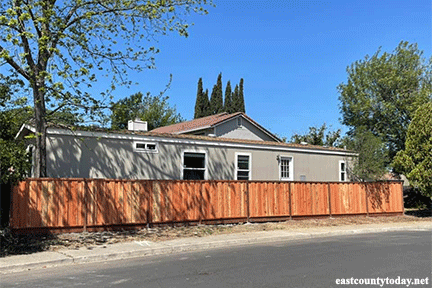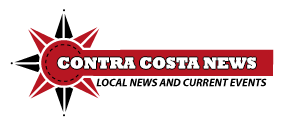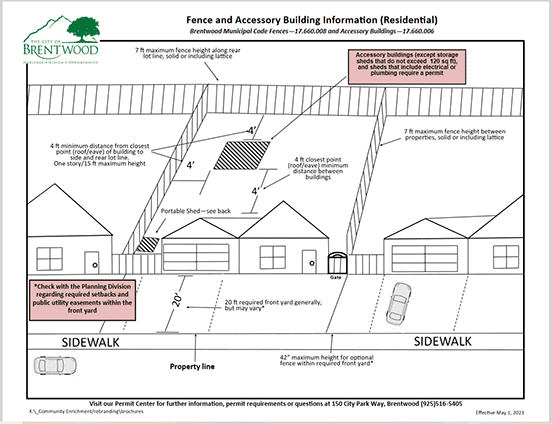The City of Brentwood has made changes to its municipal code regarding accessory structures, buildings and detached structures. The updates pertain to the Accessory Building and Accessory Structure Codes. The new rules went into effect May 1, 2023 in hopes of being more clear on what is within code and what is not in code.
The city had been adjusting its municipal codes based off recent state laws that went into effect in 2021 which prompted ADU’s to be build–including one that received numerous complaints in 2021 which was allowed as the applicant filed paperwork in between state law and the city adjusting its own codes.

In 2021, this ADU was allowed after the applicant applied for a permit between the new state law going into effect and the City Council updating its own ADU ordinance.
Here is the info from the City:
On February 28, 2023, the City Council approved an amendment to the Brentwood Municipal Code Chapter 17.030 (Definitions) and Chapter 17.660 (Encroachments into Required Yards). These amendments ensure improvements are built to high standards for safety and compliance, ultimately enhancing property values.
The amendments will better identify regulations in the following sections:
- Attached Accessory Structures (patio covers, carports)
- Detached Accessory Buildings (detached sheds, garages, patio covers, gazebos, etc.);
- Detached Accessory Structures (landscape features such as arbors and trellises, play structures, etc.); and
- Fences and Walls.
The new updates will take effect May 1, 2023. These updates aim to provide residents with clear and comprehensive guidelines for improving their properties. Additionally, the updates will clarify fencing standards for residential properties and aid Community Enrichment staff in addressing concerns regarding accessory buildings and structures constructed within the required setback areas and/or constructed without a building permit.
The amendments reflect the City’s commitment to promoting safe and sustainable living spaces for all residents. For additional information, please view our informational handout:
- Fence and Accessory Building Information (Residential corner lot)
- Fence and Accessory Building Information (Residential).
The front yard is typically considered the first 20-feet of a property adjacent to the street measured from the property line. Within any required front yard fences shall not exceed a total height of forty-two inches.
Note: the front property line does not always start at the back of the curb or back of the sidewalk. Please contact Engineering regarding potential property lines and public utility easements within the front yard.

Fences may be a maximum of seven feet in height when located on side or rear property lines (outside of the front yard setback). Fences may be solid or include decorative lattice at the top. The total height of the fence shall be measured as the vertical distance between the finished grade at the base of the fence or wall to the top edge of the structure from the higher grade elevation.
A portable shed is defined as a pre-manufactured garden shed that is less than 120 square feet and does not exceed seven feet in height, constructed with plastic or metal, is not attached to a foundation or constructed with posts in the ground, and can be easily moved.
A portable shed is permitted anywhere outside of the front yard setback provided its height does not exceed the height of the adjacent fence up to seven feet in height, its floor area does not exceed 120 square feet, and provided there exists unobstructed access (clear passageway) with a gate leading from a street to the rear yard of at least three feet of width on at least one side of the primary dwelling. In addition, a portable shed cannot obstruct any egress or windows of a dwelling unit on the property.
Sheds are allowed in any required interior side or rear yard, provided they are a minimum of four feet from any property line, other structures or buildings, and do not exceed fifteen feet in height. In no case shall more than fifty percent of a required minimum rear yard be covered by any buildings or structures, excluding pools and spas.
A detached accessory structure or building is typically permitted in any required interior side or rear yard with a four feet setback from the adjacent property line, as measured from the closest point (e.g., roof overhang or eave if applicable).
An attached accessory structure such as an attached patio cover is typically only allowed to encroach two-feet into a required side yard setback and eight-feet into a required rear yard setback. In no case shall any portion of an attached accessory structure including eaves, result in a setback of less than three feet, measured from the closest projection. Please contact the Planning Division to determine what the required setbacks are for an attached structure.
In no case shall more than fifty percent of a required minimum rear yard be covered by any buildings or structures, excluding pools and spas.
For more information: click here
Editors Note:
March 14, 2023: Brentwood Set to Update Municipal Code Relating to Encroachments into Required Yards
The item comes as staff has seen an increase in complaints related to accessory buildings and structure which include attached structures, garages, patio covers, sheds, landscape features and more. Between 2019 to 2022, the city has received 228 complaints.
- 2019 – 24
- 2020 – 32
- 2021 – 78
- 2022 – 94
During the February 21 Planning Commission meeting, staff said they do not proactively address the issues accessory building issues, but rather respond to complaints once they are received. Staff also stated the code is not “easily understood by the public” and could be approved by amendments in definitions and terms. — ultimately, the planning commission approved it in a 4-0 vote.

